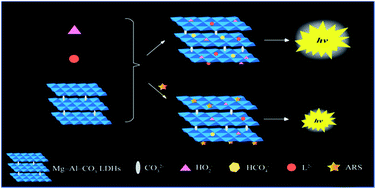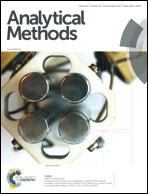Determination of alizarin red S based on layered double hydroxides-improved chemiluminescence from hydrogen peroxide and luminol†
Abstract
In this report, a simple chemiluminescence (CL) approach for detecting an anionic dye, alizarin red S (ARS), based on layered double hydroxides (LDHs)-improved CL from hydrogen peroxide (H2O2) and luminol system is proposed. The LDHs-improved H2O2–luminol CL is due to the adsorption of luminol dianion and peroxide anion onto the positively charged brucite-like layers and the facilitated formation of carbonate radicals, which benefits the generation of light-emitting intermediate 3-aminophthalate anions. Notably, the LDHs-improved H2O2–luminol CL signal is markedly restrained in the presence of ARS, which is assigned to the ARS-mediated occupation of the positively charged centres on the brucite-like layers and the inhibition of the formation of 3-aminophthalate anions. Thus, a facile CL method for ARS perception based on the suppression effect of ARS toward the LDHs-improved H2O2–luminol CL has been developed. This simple CL approach shows a limit of detection of 0.1 μM toward ARS and exhibits a linear response in the concentration range from 0.5 to 30 μM. In addition, the proposed method exhibits a high specificity toward ARS over other small molecules, metal ions or anions. Furthermore, the practical application of the proposed method for ARS sensing is evaluated with the dye wastewater samples.



 Please wait while we load your content...
Please wait while we load your content...